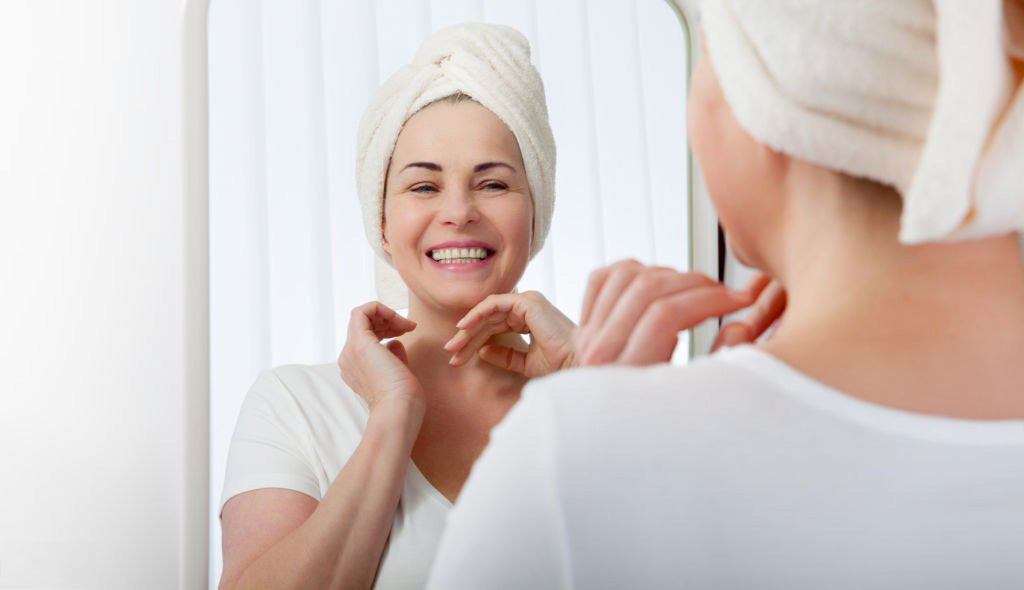As we age, our skin naturally undergoes changes—fine lines deepen, skin loses its elasticity, and dryness becomes more frequent. While many turn to anti-aging products like glycolic acid, hyaluronic acids, or retinol, some are now exploring hormone-based options like estrogen cream to address skin ageing more directly.
But what does science say about applying topical estrogen to the face? Can estrogen face cream actually increase collagen, smooth fine wrinkles, and enhance skin firmness?
Let’s explore the effects of estrogen on skin health, especially in postmenopausal women, and how topical treatment with estrogen might improve signs of aging.
Estrogen and Skin: What’s the Connection?
Estrogen is a key hormone for maintaining youthful, hydrated skin. It influences nearly every layer of the skin, from the epidermis to the dermis, and plays a major role in:
-
Collagen production
-
Skin thickness
-
Sebum production
-
Hyaluronic acid concentration
-
Wound healing
As estrogen levels decline—particularly during menopause—the skin begins to show visible signs of aging. Skin of postmenopausal women often becomes drier, thinner, and less elastic, a condition referred to in dermatology as estrogen-deficient skin.
What Is Estrogen Cream?
Estrogen cream, also known as topical estrogen, is a formulation that delivers small amounts of estrogen directly to the skin. It can come in the form of:
-
Estriol cream (a weaker form of estrogen)
-
Estradiol cream (a more potent type of estrogen)
-
Topical estriol or estradiol face cream
-
Vaginal estrogen (formulated primarily for vaginal dryness but sometimes used off-label on facial skin)
These creams may be compounded by pharmacies or prescribed in regulated doses for hormone therapy. When applied to facial skin, they interact with estrogen receptors and may influence collagen synthesis, skin hydration, and firmness.
Effects of Estrogen Cream on Facial Skin
Research, including findings from the International Journal of Dermatology and other pilot studies, has shown that topical therapy using estrogen may lead to significant changes in skin quality over time.
1. Increased Collagen and Skin Thickness
Studies have shown that topical estradiol and estriol face cream can stimulate collagen production, helping to restore epidermal thickness and skin firmness. This is particularly important in postmenopausal skin, which often loses up to 30% of its collagen in the first five years after menopause.
2. Reduced Fine Lines and Wrinkle Depth
Estrogen creams have demonstrated the ability to reduce fine wrinkles and wrinkle depth, as well as improve pore sizes. These effects are linked to improved skin surface structure and collagen density.
3. Improved Skin Moisture and Elasticity
Hyaluronic acid concentration increases with estrogen use, leading to better skin hydration and elasticity. Women with estrogen-deficient skin often report visibly improved skin tone and texture within 8–12 weeks of using topical estrogen.
4. Better Sebum Production and Barrier Function
Increased sebum production helps with skin lubrication, especially in cases of skin dryness associated with aging. Estrogen also enhances the skin’s barrier function, reducing trans-epidermal water loss.
What About Systemic Absorption?
A major concern with using estrogen facial cream is the possibility of systemic absorption—where estrogen enters the bloodstream and affects the body as a whole.
While topical vaginal estrogen is designed to limit this, using estradiol face cream or estriol cream may still lead to minor absorption depending on the dose, frequency, and area of application.
That’s why it’s crucial to:
-
Use only under the guidance of a healthcare provider
-
Start with low-dose formulations
-
Monitor for any hormonal side effects
For those who already use systemic hormone replacement therapy, a topical face cream may complement the treatment of skin aging symptoms without significantly altering hormone levels.
Key Differences Between Estriol and Estradiol Cream
Not all estrogen creams are the same. The type of estrogen used can influence both effectiveness and safety.
-
Estriol: Considered a “weak” estrogen, often used in topical vaginal or facial creams. It has a lower risk of systemic hormonal effects and is commonly used in Europe for skin health.
-
Estradiol: A stronger form of estrogen, often used in systemic hormone replacement. When used topically, it can result in greater systemic absorption if not monitored carefully.
Each may benefit the facial skin of postmenopausal individuals, but estriol cream is often favored for its safety profile and its role in topical treatment of Estrogen Deficient Skin.
Are Estrogen Creams Clinically Proven?
Yes—several pilot studies and dermatological trials have demonstrated the effects of topical estrogen on the face, including:
-
Increased collagen synthesis
-
Reduced fine lines
-
Enhanced skin elasticity
-
Significantly improved hydration and tone
These findings are consistent across small-scale trials and compounding pharmacy case reports, though more large-scale research is still needed.
Who Might Benefit from Estrogen Cream?
Estrogen cream may be considered for:
-
Postmenopausal women experiencing facial dryness or sagging
-
Individuals with estrogen deficiency not currently on HRT
-
Those interested in topical therapy with minimal systemic effect
-
People exploring alternatives to standard anti-aging facial creams
However, it’s essential to remember that estrogen therapies—even in cream form—can carry risks and must be managed under the supervision of a professional.
Potential Side Effects and Precautions
Although topical estriol is considered low-risk, some possible hormonal side effects include:
-
Skin irritation or redness
-
Hormonal fluctuations if overused
-
Interaction with other hormone replacement products
-
Unintended systemic hormonal effects with prolonged use
Always check with a healthcare provider before starting any form of estrogen to treat age skin or skin aging symptoms.
Final Thoughts
So, is estrogen cream good for your face? For many—especially those with postmenopausal skin or estrogen deficiency—the answer may be yes. By promoting collagen production, reducing fine lines, and improving skin moisture, topical estrogen can offer measurable improvements in skin quality.
However, due to the potential for systemic absorption and hormonal side effects, these creams should be used cautiously and under professional supervision. With the right formulation, dosage, and oversight, estrogen facial cream can be a powerful ally in the ongoing pursuit of skin health and rejuvenation.



